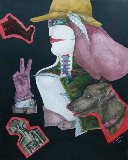



Moonbeam Passing PP 1992
Erwin Eisch
Limited Edition Print : Lithograph
Size : 30x22 in | 76x56 cm
Edition : From the PP Edition
Motivated Seller Reduced
-
🔥1992 Limited Edition Printers Proof Lithograph - Inquire $$$$$$$
Year1992
Hand SignedLower Left
Condition Mint
Not Framed
Purchased fromOther 1992
Certificate of AuthenticityArt Brokerage
LID77376
Erwin Eisch - Germany
Art Brokerage: Erwin Eisch German Glass Artist: He is a German artist who works with glass. He is also a painter, draughtsman and printmaker. With that of his friend and colleague in glass, Harvey Littleton, Eisch's work in glass embodies the ideas of the international Studio Glass movement. Along with glass artists Sam Herman and Sybren Valkema, Eisch is considered a founder of Studio Glass in Europe. Harvey Littleton called his first meeting with Erwin Eisch "a milestone" in his development as a glass artist. In August 1962 Littleton was visiting Germany on a research grant when he noticed, in the showroom of the Rimpler Kristall glass factory in Zwiesel, a piece of glass that was unlike the other objects on display. Littleton was told that it was from the Eisch Glass Factory in the nearby town of Frauenau. Visiting the Eisch factory, Littleton met Erwin Eisch and marveled at his expressionistic free-blown glass objects. "Meeting Erwin confirmed my belief that glass could be a medium for direct expression by an individual," he wrote. Although many of Eisch's pieces of the 1960s and '70s was rooted in functional forms such as the vase, the bottle, the pitcher and the stein, the usefulness of these vessels was never Eisch's goal. "The purely plastic form, with glass as medium, was a means of art free of an end," he wrote. Eisch described his own glass forms of the sixties and seventies as "poetic or pictorial realism." He made clear that such a realism did not rely on observable fact, but on his inner reality; his fantasies. As important as his reliance on fantasy was to shaping his art, his unwillingness to compromise personal vision to appeal to the marketplace was just as vital. Therefore his early pitchers, vases and teapots are so eccentrically shaped as to seem to be in the process of becoming, rather than being, commonplace objects. Unique and imperfect as Eisch's forms are, it is not much of a step for their creator to anthropomorphize them. Eisch said, "From a glowing inert mass must emerge things of beauty that are endowed with speech. A talent of innovating, creating animatedly, and beginning in the mid-1970s Eisch began to create more and more in the traditional art forms of painting on canvas and paper, drawing and printmaking. Eisch draws daily, often working in thematic series. While his imagery can be purely whimsical, the artist also uses it to make political statements. Above all, his guiding idea is the physical relationship of male and female, of human contact through touch with an emphasis on the hand. Eisch first tried his hand at vitreography (printmaking from glass plates) during a visit to Harvey Littleton's studio in 1981. In addition to teaching in the glass program at the University of Wisconsin in 1964 and 1968, Eisch has been a guest instructor at San Jose State University (1968), Haystack Mountain School of Crafts in Maine (1972), Foley College of Art, Stourbridge, England (1974) and Alfred University in New York (1976). In addition he taught various subjects, including drawing, glass painting, sandblasting and engraving at Pilchuck Glass School in 1981, 1983 and 1984. Eisch lectured at the XIII International Congress on Glass in London, England (1968), the World Crafts Conference in Dublin, Ireland (1970), the World Crafts Conference in Kyoto, Japan (1978), the Glass Art Society Conferences in New York City (1982) and in Corning, New York (1979, 1991). He was also an organizer of the First and Second International Glass Symposia in Frauenau, Germany in 1982 and 1985. In 1988 Eisch founded the summer school Bild-Werk Fauenau in Frauenau, Germany. In 2008 Bild-Werk Frauenau offered four summer sessions and 36 courses in subjects ranging from painting and drawing, to cutting and engraving glass, to singing. Listings wanted by Art Brokerage.

















































